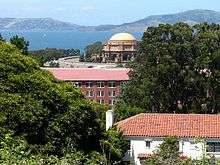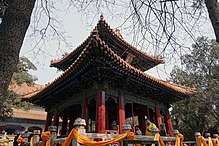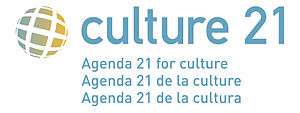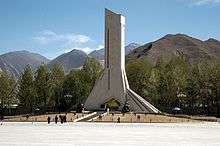Cultural governance
Cultural governance is governance of culture. It includes cultural policy made by governments but extends also to cultural influence exerted by non-state actors and to policies which influence culture indirectly.


Meaning
The tendency to discuss cultural governance rather than policy corresponds to the broader shift from government to governance, with the emphasis shifting from state policymakers to include the influence of civil society organizations and the private sector. A broad interpretation of "governance" could also include government policies outside the scope of cultural policy which nevertheless impact culture.[3]
The precise meaning of "cultural governance" also depends heavily on the definition of culture, which can range from narrow reference to institutions like museums and concert halls connected with the arts to broad meanings such as a society’s way of life or its systems of knowledge and symbols.[4] In the broader view, cultural governance deals holistically with the production of meaning in a society, through aspects including the culture industry, the formation of taste, and the use of language.[5]
Global
The dominant actor in global cultural governance is UNESCO, a United Nations specialized agency created in 1946 and headquartered in Paris, France.[6] UNESCO produces documents which local governments frequently use as guidelines and may incorporate into law. It has also promoted the development of networks such as the Global Alliance for Cultural Diversity to promote public/social/private partnership in the cultural area. In recent years the organization has emphasized the importance of cities (with non-profit organizations participating in local governance) as cultural actors with networks such as the International Coalition of Cities Against Racism and the Creative Cities Network.[6]

UNESCO itself relies upon partnerships with the private sector in selecting, developing, and promoting World Heritage Sites.[6] Meetings for the selection of these sites attract several hundred attendees, including representatives of interested groups. "World heritage" issues gain prominence through promotion in the mass media with publications such as National Geographic and many others. All steps of the process promote the development of a metaculture capable of adjudicating global cultural issues and producing a global literary canon from a vantage point of universality.[5][7]
Agenda 21 for culture, administered by an international organization called United Cities and Local Governments, represents a vector for global governance conducted by its members at a local level.[6] This concept endorses "culture as a fourth pillar of sustainable development", adding to the three pillars of sustainable development identified in Agenda 21: economy, society, and environment.[6]
Regional and local
European Union
Cultural governance in the European Union includes a range of cultural policies geared toward promoting European culture.
The European Commission's 2007 communication "on a European agenda for culture in a globalizing world" describes interaction with culture through a various channels, including support for and consultation with cultural organizations, encouragement of artist mobility and intercultural communication, use of European culture in international relations, maintenance of EU copyright law, and promotion of European cultural goods and services.[9][10] The European governments consider it necessary to promote and guide cultural development actively because of deficiencies in cultural outcomes of the free market. Further, intercultural communication and integration are considered intertwined with economic integration.[10]
China

In the People's Republic of China a major goal of cultural governance is to reinforce the legitimacy of the government.[11] Culture has long played a role in the governance of China, from the harmonious society promoted by Confucianism to the Cultural Revolution and other Chinese Communist Party strategies for transforming traditional society into industrialized communism. Present-day Chinese leaders have made significant references in speeches to a continual tradition of Chinese culture and its importance for nationalist and geopolitical purposes. Cultural governance is integrated with propaganda, censorship, music, and education.[11] Within the Chinese Ministry of Culture, the State Administration of Cultural Heritage has stated that China's cultural heritage should be used to "strengthen national unity and promote sustainable development of the natural culture".[12]
Localities in China have assumed much of the responsibility for identifying heritage sites, with the result that 300,000 such sites have been declared, many without state protection and support. Local governments have frequently turned to private companies to manage these sites and operate tourism businesses.[12][2] Sites may also come under many overlapping authorities, as in the case of Mount Wutai, a national park and World Heritage Site, which is managed by eight government agencies and governed by 29 international, national, and local laws.[13]
| Part of a series on |
| Governance |
|---|
| Models |
|
| By level |
|
| By field |
| Measures |
| Related topics |
References
- Macdonald & Cheong, pp. 44–48.
- Songshan (Sam) Huang, Chris Ryan, & Chunyu Yang, "Local Governments' Roles in Developing Tourism"; in Chris Ryan & Songshan (Sam) Huang, eds., Tourism in China: Destinations, Planning and Experiences; Bristol, Buffalo, & Toronto: Channel View Publications, 2013; p. 202.
- Schmitt (2011), pp. 48–49. “In order to be able to understand the governance of a cultural object, this must not just be considered alone, but also in the light of the often conflicting overlaps and interferences between different fields of governance that have an interest in the “cultural object”. Such considerations lead to the concept of cultural governance in the broad sense. For example, the members of a theater ensemble may be bound by labour regulations, or the treatment of a historic building may be determined by fire prevention regulations or the specific interest of the users.”
- Schmitt (2011), pp. 11–18. Concepts or ideas thus have a twofold dialectical relationship with human agency on the one hand, and institutions on the other hand: concepts or ideas have a discursive influence on human agency, shaping actions, whether consciously, practically or unconsciously (see also Giddens 1984, Werlen 1997: 153). However, when actors take up ideas and appropriate them for themselves, they can change them, or they can create new ideas; they do not always have to act as passive recipients and actualizers of discourses. There is also a dialectical relationship between ideas and concepts on the one hand, and institutions on the other hand; but strictly speaking this relationship is always mediated by human agency. Political institutions (such as UNESCO) can take up and spread ideas, and can also reshape them. Ideas and institutions mutually “frame” each other (for a neo-Gramscian view, see Bøås/ McNeill 2004). / Ideas, symbols, concepts constitute one pole of the cultural sphere, while the other pole is made up of actions and practices (especially rituals and performances) and the material (or digital) artefacts in which concepts, ideas, senses and meanings are manifested.”
- Thomas M. Schmitt, “Global Cultural Governance: Decision-Making Concerning World Heritage Between Politics and Science”; Erdkunde 63(2), 2009.
- Nancy Duxbury & Sharon Jeannotte, "Global Cultural Governance Policy"; Chapter 21 in The Ashgate Research Companion to Planning and Culture; London: Ashgate, 2013. "While global entities such as the World Bank or the World Trade Organization have played roles in global cultural governance, the primary actor in this policy area over the past 40 or 50 years has been the United Nations Educational, Scientific and Cultural Organization (UNESCO)."
- Barbara Kirshenblatt-Gimblett, “Intangible Heritage as Metacultural Production”; Museum International, June 2004; doi:10.1111/j.1350-0775.2004.00458.x.
- Cristina Sánchez-Carretero, "Heritage Regimes and the Camino de Santiago: Gaps and Logics"; in Regina F. Bendix, Aditya Eggert, & Arnika Peselmann, eds., Heritage Regimes and the State, Göttingen Studies in Cultural Property, Volume 6; Universitätsverlag Göttingen, 2012; ISBN 978-3-86395-075-0.
- Commission of the European Communities, Communication from the Commission to the European Parliament, the Council, the European Economic and Social Committee and the Committee of the Regions; Brussels, 10 May 2007.
- Rachael Craufurd Smith, “The Cultural Logic of Economic Integration”; in Psychogiopoulou (2015).
- Elizabeth J. Perry, Cultural Governance in Contemporary China: “Re-Orienting” Party Propaganda; Harvard-Yenching Institute Working Paper Series, 2013. "Despite such monumental ideological and institutional changes, however, the contemporary Chinese state also leans heavily on cultural governance. While far from 'traditional' in its espoused secularism and embrace of a 'scientific development outlook,' the PRC continues to devote considerable attention and energy to the exercise of symbolic power as a means to affirm its right to rule. [...] China's rulers today are quite explicit in the high value they put on cultural governance. They are almost equally explicit in their instrumental use of cultural governance for nationalistic ends."
- Shepherd & Yu (2013), pp. 49–51.
- Shepherd & Yu (2013), p. 53. "Mount Wutai, a sacred Buddhist mountain area designated a national park in 1982 and inscribed as a world heritage site in 2009, illustrates this fragmented bureaucratic structure of competing interests. Overall management authority is shared by the Ministry of Housing and Urban–rural Development and the Construction Authority of Shanxi Province. But the park’s forest reserves are overseen by the State Forestry Administration, temple sites by the State Administration of Cultural Heritage, religious practice at temples and monasteries by the State Administration for Religious Affairs, geological sites by the Ministry of Geology, fossils by the Ministry of Land and Resources, and tourism by the National Tourism Administration. Finally, 29 different international, national, and provincial conventions, laws, and decrees impact the site (Shepherd 2012 ) . These range from the 1972 Convention on World Heritage and various State Council decrees on heritage protection to national laws regulating geological heritage (1995), forests (1998), fossils (2002), cultural relics (2003), religious practice (2004), and scenic areas (2006)."
Bibliography
- Macdonald, Susan & Caroline Cheong (2014). The Role of Public-Private Partnerships and the Third Sector in Conseving Heritage Buildings, Sites, and Historic Urban Areas. Los Angeles: Getty Conservation Institute. ISBN 978-1-937433-19-2.
- Psychogiopoulou, Evangelia (2015). Cultural Governance and the European Union: Protecting and Promoting Cultural Diversity in Europe. Palgrave- Macmillan. ISBN 978-1-137-45375-4.
- Schmitt, Thomas (2011). Cultural Governance as a conceptual framework. Max Planck Institute for the Study of Religious and Ethnic Diversity. MMG Working Paper 11-02. ISSN 2192-2357.
- Shepherd, Robert J. & Larry Yu (2013). Heritage Management, Tourism, and Governance in China: Managing the Past to Serve the Present. Springer Science+Business Media. ISBN 978-1-4614-5918-7.